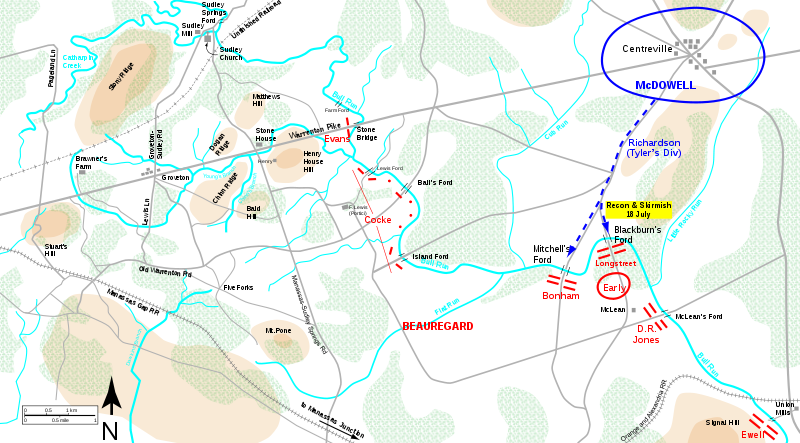 | ||
| Blackburn's Ford-July 18, 1861 (Wikipedia) |
Report of Brig. Gen. Daniel Tyler, Connecticut Militia, of action at Blackburn’s Ford
HDQRS. FIRST DIV. DEP’T NORTHEASTERN VIRGINIA,
Washington City, July 27, 1861.
SIR: On the18th instant you ordered me to take my division, with the two 20-pounder rifled guns, and move against Centreville, to carry that position. My division moved from its encampment at 7 a.m. At 9 a.m. Richardson’s brigade reached Centreville, and found that the enemy had retreated the night before---one division on the Warrenton turnpike in the direction of Gainesville, and the other, and by far the biggest division, towards Blackburn’s Ford, on Bull Run. Finding that Richardson’s brigade had turned towards the latter point and halted, for the convenience of obtaining water, I took a squadron of cavalry and two light companies from Richardson’s brigade, with Colonel Richardson, to make a reconnaissance, and in feeling our way carefully we soon found ourselves overlooking the strong position of the enemy, situation at Blackburn’s Ford , on Bull Run. A moment’s observation discovered a battery on the opposite bank, but no great body of troops, although the usual pickets and small detachments showed themselves on the left of the position.
Suspecting from the natural strength which I saw the position to possess that the enemy must be in force, and desiring to ascertain the extent of that force and the position of his batteries, I ordered up the two rifled guns, Ayres’ battery, and Richardson’s entire brigade, and subsequently Sherman’s brigade in reserve, to be ready for any contingency. As soon as the rifled guns came up I ordered them into battery on the crest of the hill, nearly a mile from a single battery which we could see placed on the opposite side of the run. Ten or a dozen shots were fired, one of them seeming to take effect on a large body of cavalry, who evidently thought themselves out of range.
Report of Col. Israel B. Richardson, Second Michigan Infantry, of action at Blackburn’s Ford.
CAMP 4TH BRIG. 1ST DIV., GENERAL MCDOWELL’S CORPS.
In Front of Blackburn’s Ford, on Bull Run, July 19, 1861.
GENERAL: ….I pushed forward the skirmishers to the edge of the woods, they driving in those of the enemy in fine style, and then brought up the First Massachusetts Regiment to their support, the skirmishers still advancing into the woods.
Captain Brackett’s squadron of the Second Cavalry, and two 12-pounder howitzers, commanded by Captain Ayres, Fifth U. S. Artillery, now moved up into an opening in the woods in support. The enemy also opened another battery, more to our left, so as to cross-fire with the other upon the road. I ordered up at this time the Twelfth New York Regiment, Colonel Walrath, to the left of our battery, and it being formed in line of battle, I directed it to make a charge upon their position, the skirmishers still pushing forward and drawing the enemy’s fire, but keeping themselves well covered. I now left the position of the Twelfth New York Regiment, to place upon the right of the battery the Massachusetts and Second and third Michigan Regiments, when a very heavy fire of musketry and artillery was opened by the enemy along his whole lone. On moving towards our left, I found that the Twelfth New York Regiment had fallen back out of the woods in disorder, only parts of two companies, some sixty men in all, remaining in line, and retreating. Our left was thus exposed, although the skirmishers still held the ground in the woods, and the three remaining regiments on the right remained firm and determined.
I now reported to General Tyler that the main body of the New York regiment had fallen back in confusion, and I proposed to make a charge with the three remaining regiments for the purpose of carrying the enemy’s position. The general replied that the enemy were in large force and strongly fortified, and a further attack was unnecessary; that it was merely a reconnaissance which he had made; that he found where the strength of the enemy lay, and ordered me to fall back in good order to our batteries on the hill, which we did, the enemy closing his fire before we left the ground, and not venturing to make an effort to follow us.
Report of Brig. Gen. James Longstreet, C. S. army, of action at Blackburn’s Ford.
….A fire from the artillery of the enemy was kept up about half an hour, when their infantry was advanced to the attack. He made an assault with column or three or four thousand of his infantry, which, with a comparatively small force of fresh troops, was with some difficulty repelled. A second and more determined attack was madw after a few minutes, which was driven back by the skirmishers, and the companies of the reserve thrown in at the most threatened and weakest points. I then sent a staff officer to Colonel Early for one of the reserve regiments of his brigade. Before the arrival of that regiment a third, though not so severe, attack was made a repulsed…..
Official Records Series I, Vol. 2, Pages 348-351, 461-463.
Tyler made a reconnaissance in force against the brigades of Bonham (at Mitchell’s Ford) and Longstreet (at Blackburn’s Ford). Casualties were under 100 on each side. The main impact of the battle was to hearten the Confederates and discourage the Union forces. From a purely tactical standpoint, the strength of the Confederate positions probably made McDowell more inclined to move against the flanks of Beauregard’s position and avoid direct assaults across Bull Run.
No comments:
Post a Comment